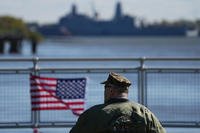The head of Army operations said Wednesday that the service is resuming large-scale combat training exercises in spite of the recent rise in coronavirus cases across the country.
"We remain in a fight with a pathogen that is changing," Lt. Gen. Charles Flynn, the Army's G3/5/7, said during an Association of the United States Army Noon Report webinar.
After a brief reduction in cases, COVID-19 continues to spread across the globe as infections reached 15 million, Bloomberg reported.
Read Next: Top Admiral in Pacific Defends Decision to Send Navy Carrier to Vietnam
COVID-19 hot spots have emerged across the U.S., causing many public school systems to scale back plans to reopen in the fall and to plan for virtual instruction instead.
Cases in the military increased more than 41% in June among service members, dependents and Defense Department civilians.
The Army, however, remains confident in the protocols it has put in place and has resumed large-scale rotations at both the Joint Readiness Training Center at Fort Polk, Louisiana, and the National Training Center at Fort Irwin, California, Flynn said.
NTC, JRTC and Joint Multinational Readiness Center (JMRC) in Hohenfels, Germany, hold brigade-level training exercises for armor, infantry and Stryker brigade combat teams and are a key measurement for the service's combat readiness.
The Army halted rotations to NTC and JRTC in mid-March to limit the spread of the virus.
Now, units go through a "series of checks ... at home station and then we do the same thing on arrival at the combat training centers," Flynn said. "We have layered in extra testing capabilities and capacity."
In May, Army senior leaders announced guidance to units across the service that empowered senior commanders "to calibrate the kind of training that they need to do on each one of their installations," he said.
"When the pathogen first hit ... we had to stop and really put a pause and slow the Army way down," Flynn said. "We went down to about 10 miles per hour.
"And now with the combat training centers opening back up and home station training beginning again ... and then other tactical operations and deployments going on across the globe, I would say we are picking up our speed."
While training slowed during the first half of the year, Flynn said that units in the active-duty force, National Guard and Reserve have conducted large-scale real-world mission in response to the pandemic and supported federal, state and local authorities as civil unrest gripped the country in the wake of the death of George Floyd, an unarmed Black man who died after being taken into custody by Minneapolis police.
"It's unprecedented and unparalleled -- an enormously complex operation that was conducted only because the Army is ready in crisis to respond to these unplanned events," Flynn said. "We must be ready for any planned and unplanned crisis. We have to be able to do this any time, any place against any threat whether it's a hurricane, whether it's a wildfire, a terror attack, a nation-state armed aggressor or even a global pandemic."
-- Matthew Cox can be reached at matthew.cox@military.com.
Related: NYC Bound: Inside the Army's Emergency Deployment of Doctors to Manhattan














